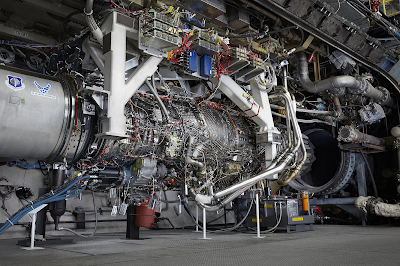In the world of military aviation, the F-35 fighter jet has long been a subject of controversy and debate. Recently, a public dispute erupted regarding the future of the F-35's engine, sending shockwaves through the defense industry and capturing the attention of enthusiasts and experts alike. In this article, we delve into the details of this heated war over the F-35's engine and its implications for the future of aerial warfare.
 |
| War Over Future Of F-35’s Engine Explodes Publicly |
1. The F-35: A Revolutionary Fighter Jet
The F-35, also known as the Joint Strike Fighter, is a fifth-generation stealth aircraft developed by Lockheed Martin. It has been hailed as a game-changer in modern warfare due to its advanced capabilities, including stealth technology, unmatched maneuverability, and an array of sophisticated sensors. The F-35 is designed to excel in air-to-air combat, air-to-ground strikes, and intelligence gathering.
2. The Engine Controversy Unveiled
2.1 The Current Engine
The F-35 is currently powered by the Pratt & Whitney F135 engine, which has been the subject of both praise and criticism. While the engine delivers impressive performance, there have been concerns about its cost, maintenance requirements, and overall reliability.
 |
| Air Force's Engine Test Rig at AEDC Advances Pratt & Whitney's XA101 Design |
2.2 The Challenger: GE's Alternative Engine
General Electric (GE) has been a long-standing competitor of Pratt & Whitney in the aerospace industry. GE developed an alternative engine for the F-35, the F136, which was intended to offer an alternative powerplant for the fighter jet. However, the F136 engine program faced significant challenges, including budgetary constraints and political pressures.
2.3 The Battle Begins
The battle over the future of the F-35's engine exploded publicly when key stakeholders voiced their opinions and entered into a fierce debate. Proponents of the Pratt & Whitney engine argue that it is the best choice due to its proven performance and existing infrastructure. On the other hand, supporters of the GE engine claim that it offers cost savings, improved maintenance, and increased competition within the industry.
3. Arguments for Pratt & Whitney
3.1 Performance and Reliability
The Pratt & Whitney F135 engine has undergone extensive testing and is currently in use by numerous F-35s.
It has demonstrated impressive performance capabilities, providing the necessary thrust and power for the aircraft's missions.
The engine's reliability record, although not flawless, is considered satisfactory by many experts.
GE's XA100 engine on a test stand. GE Aviation
3.2 Existing Infrastructure
The Pratt & Whitney engine is already integrated into the F-35 fleet, with supply chains, maintenance facilities, and logistics in place.
Switching to a new engine would require significant investments and could disrupt the ongoing operations of the F-35 program.
3.3 Established Partnership
Pratt & Whitney has a long-standing partnership with Lockheed Martin, the manufacturer of the F-35.
The collaboration between the two companies has resulted in valuable synergies and expertise in integrating the engine with the aircraft's design.
4. Arguments for General Electric
4.1 Cost Efficiency
Proponents of the GE engine argue that it offers potential cost savings compared to the Pratt & Whitney engine.
The introduction of competition into the engine market could lead to more favorable pricing for the F-35 program.
4.2 Enhanced Maintenance
GE's engine design incorporates features that simplify maintenance procedures, reducing downtime and overall maintenance costs.
Improved maintenance efficiency could enhance the availability and readiness of the F-35 fleet.
4.3 Promoting Competition
Introducing the GE engine as an alternative powerplant for the F-35 could foster competition in the defense industry.
Increased competition often leads to innovation, cost reduction, and overall improvement in product quality.
5. Implications for the Future of Aerial Warfare
The outcome of the war over the F-35's engine will have far-reaching implications for the future of aerial warfare. Here are some key points to consider:
The chosen engine will significantly impact the operational costs and capabilities of the F-35 fleet.
The decision will shape the future of engine development and competition in the defense industry.
It could influence the strategic relationships and partnerships between aerospace manufacturers.
Conclusion
The war over the future of the F-35's engine has brought to light the diverging opinions and interests within the defense industry. As the battle rages on, the decision-makers must carefully consider the technical, financial, and strategic implications of their choice. Ultimately, the fate of the F-35's engine will not only shape the future of the aircraft but also impact the landscape of aerial warfare.
FAQs (Frequently Asked Questions)
Q: Why is the F-35's engine such a controversial topic?
A: The engine choice affects performance, cost, and competition within the defense industry, leading to differing opinions and heated debates.
Q: What are the main advantages of the Pratt & Whitney engine?
A: The Pratt & Whitney engine offers proven performance, reliability, and an existing infrastructure that supports the F-35 program.
Q: How does General Electric's engine differ from Pratt & Whitney's?
A: GE's engine provides potential cost savings, enhanced maintenance features, and the promotion of competition in the defense industry.
Q: What are the implications of the engine choice for aerial warfare?
A: The chosen engine will impact the operational costs, capabilities, and future development of the F-35, influencing the landscape of aerial warfare.
Q: Who will make the final decision regarding the F-35's engine?
A: The decision will likely involve key stakeholders, including government officials, defense contractors, and military experts.
Q: Are there any other alternative engines under consideration?
A: Currently, the GE engine remains the primary alternative to the Pratt & Whitney engine for the F-35.
Q: How long has the war over the F-35's engine been going on?
A: The dispute over the engine choice has been ongoing for several years, with stakeholders expressing their opinions and advocating for their preferred engine.
Q: When can we expect a final decision on the F-35's engine?
A: The timeline for the decision is uncertain and will depend on various factors, including budgetary considerations, technical evaluations, and political dynamics.


